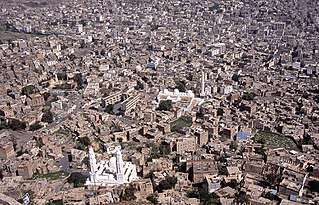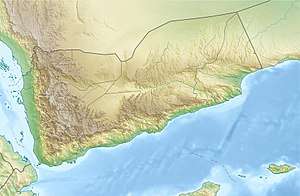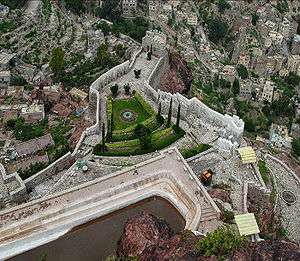Taiz
| Taiz تعز | |
|---|---|
| City | |
_(cropped).jpg)  .jpg) _(2).jpg)  Overview of Taiz | |
 Taiz Location within Yemen | |
| Coordinates: 13°34′44″N 44°01′19″E / 13.57889°N 44.02194°E | |
| Country | Yemen |
| Governorate | Taiz |
| Elevation | 1,400 m (4,600 ft) |
| Population (2014) | |
| • Total |
2,612,222 |
| Time zone | UTC+3 (Yemen Standard Time) |

Taiz (Arabic: تعز, Taʿizz) is a city in southwestern Yemen. It is located in the Yemeni Highlands, near the port city of Mocha on the Red Sea, lying at an elevation of about 1,400 metres (4,600 ft) above sea level. It is the capital of Taiz Governorate. With a population of over 600,000 in 2005, it is the third largest city in Yemen after the capital Sana'a and the southern port city of Aden. Taiz is considered to be the cultural capital of Yemen.
History
In 130 CE the Jewish quarter was established in the city. One of the famous and most accepted traveler in Taiz was Ibn Battuta. In his travels he describes this city as "one of the most beautiful and extensive cities of Yemen." Ibn was invited to a banquet with the king and received a warm and inviting welcome. [1]
Islamic era
Taiz was ruled by Turan-Shah, the older brother of Saladin, after he had conquered Yemen in 1173 CE.[2] Turan-Shah built the citadel on the hill overlooking the old city.[3] In 1175 CE, Taiz was made the capital of Yemen as it was incorporated into dominions of the Ayyubid dynasty by Turan-Shah.
The second Rasulid King, Almaddhafar (1288 CE), established Taiz as the second capital of the Rasulid Dynasty after Zabid.[4] In 1332 Ibn Battutah visited Taiz and described it as one of the largest and most beautiful cities of Yemen.[5]
In the 1500, the capital is moved to Sana'a by the ruler of the Taharid dynasty. In 1516 Taiz comes under Ottoman control.
20th Century
In 1918 the Ottomans lost Taiz to the new independent Yemen.
Taiz remained a walled city until 1948 when Imam Ahmed made it the second capital of Yemen, allowing for expansion beyond its fortified wall.[6]
In the 1960s, the first purified water system in Yemen is opened in Taiz. In 1962, state administrations move back to Sana'a.
2011 Yemeni uprising
During the Yemeni Revolution fighting in Taiz resulted in anti-government forces seizing control of the city from president Ali Abdullah Saleh.
As part of the 2015 Yemeni Civil War, on 22 March 2015, the Houthis and forces loyal to former president Ali Abdullah Saleh took the city in the aftermath of their coup d'état in Sana'a.[7] Then the city endured a military confrontation between Houthis and the forces loyal to Abd Rabbuh Mansur Hadi. The city was effectively under siege and the United Nations warned of an "extreme and irreversible" food shortage if fighting continued.[8] In August 2015 Yemeni MP Muhammad Muqbil Al-Himyari reported Houthi attacks on civilians in Taiz and appealed for help on Suhail TV (Yemen).[9][10]
Geography
Climate
Taiz has a Humid subtropical climate. The average daily temperature high during August is 33 °C (91 °F). Annual rainfall of Taiz is around 600 millimetres (24 in), but on Jabal Sabir it is probably around 1,000 millimetres (39.4 in) per year.
| Climate data for Taiz | |||||||||||||
|---|---|---|---|---|---|---|---|---|---|---|---|---|---|
| Month | Jan | Feb | Mar | Apr | May | Jun | Jul | Aug | Sep | Oct | Nov | Dec | Year |
| Average high °C (°F) | 24.3 (75.7) |
26.4 (79.5) |
27.9 (82.2) |
28.3 (82.9) |
29.0 (84.2) |
31.3 (88.3) |
32.5 (90.5) |
31.7 (89.1) |
31.3 (88.3) |
31.1 (88) |
27.6 (81.7) |
26.1 (79) |
29.0 (84.2) |
| Average low °C (°F) | 11.1 (52) |
13.3 (55.9) |
16.3 (61.3) |
18.8 (65.8) |
19.5 (67.1) |
19.9 (67.8) |
20.2 (68.4) |
19.1 (66.4) |
17.8 (64) |
16.9 (62.4) |
15.7 (60.3) |
13.9 (57) |
16.9 (62.4) |
| Average rainfall mm (inches) | 9 (0.35) |
12 (0.47) |
37 (1.46) |
68 (2.68) |
89 (3.5) |
73 (2.87) |
60 (2.36) |
89 (3.5) |
110 (4.33) |
91 (3.58) |
17 (0.67) |
5 (0.2) |
660 (25.97) |
| Source #1: Hydrological Sciences[11] | |||||||||||||
| Source #2: Journal of Environmental Protection[12] | |||||||||||||
Landmarks
The city has many old and beautiful quarters, with houses that are typically built with brown bricks, and mosques are usually white. Most famous among the mosques are the Ashrafiya, the Muctabiya and the Mudhaffar. Also memorable are the old citadel and the governor's palace that rests on top of a mountain spur 450 metres above the city centre. It also has one of the most famous mountains in Yemen, the Saber mountain (almost 3000 meters above sea level), which affords panoramic views over the city. The city has a Muslim madrasa that has university status.
Economy
Historically, the mountainous city of Taiz was known for coffee production. The coffee produced in Taiz was considered some of the finest in the region in the early 20th century.[13] Today, coffee remains a major part of the economy but mango, pomegranate, citrus banana, papai, vegetables, cereals, onions, and qat are also grown in the surrounding landscape.[14] Cheese from Taiz is also renowned throughout Yemen.
Industries in the city of Taiz include cotton-weaving, tanning and jewelry production. Taiz today is the largest industrial base in Yemen.
Transport
Taiz has many road connections with the rest of the country. The city is served by Ta'izz International Airport.
References
- ↑ Ibn Battuta, The Travels of Ibn Battuta
- ↑ Lane-Poole, Stanley (2013-10-03). A History of Egypt: Volume 6, In the Middle Ages. Cambridge University Press. p. 197. ISBN 9781108065696.
- ↑ Steven C. Caton: Yemen. ABC-CLIO, 2013, p.52
- ↑ Mackintosh-Smith, Tim (2014-06-03). Yemen: The Unknown Arabia. The Overlook Press. p. 305. ISBN 9781468309980.
- ↑ First Encyclopaedia of Islam: 1913-1936. BRILL. 1993. p. 626. ISBN 9004097961.
- ↑ Gibb, Hamilton Alexander Rosskeen (1998). The Encyclopaedia of Islam: TAHRIR-TARDJAMA. Brill. p. 118.
- ↑ "Rebels Seize Key Parts of Yemen's Third-Largest City, Taiz". The New York Times. 22 March 2015. Retrieved 22 March 2015.
- ↑ "UN warns of 'extreme' and 'irreversible' food shortage in Taiz". Al Jazeera. Al Jazeera. 30 October 2015. Retrieved 14 November 2015.
- ↑ "#5060 - Yemeni MP Muhammad Muqbil Al-Himyari Breaks Down in Tears When Discussing Situation in Taiz, Yemen Suhail TV". Memritv. August 24, 2015.
- ↑ "Transcript #5060 - Yemeni MP Muhammad Muqbil Al-Himyari Breaks Down in Tears When Discussing Situation in Taiz, Yemen". Memritv. August 24, 2015.
- ↑ "Rainfall and Runoff in Yemen" (PDF). Hydrological Sciences. Archived from the original (PDF) on 2013-05-12. Retrieved 2013-03-18.
- ↑ Al-Buhairi, Mahyoub H.; "Analysis of Monthly, Seasonal and Annual Air Temperature Variability and Trends in Taiz City - Republic of Yemen"; in Journal of Environmental Protection, 2010 (1) ; pp. 401-409
- ↑ Prothero, G.W. (1920). Arabia. London: H.M. Stationery Office. p. 83.
- ↑ Yementourism.com, http://www.yementourism.com/services/touristguide/detail.php?ID=2044
External links
![]()
- ArchNet.org. "Taizz". Cambridge, Massachusetts, USA: MIT School of Architecture and Planning. Archived from the original on 2008-05-05.
Coordinates: 13°34′44″N 44°01′19″E / 13.57889°N 44.02194°E
_Al-Ashrafiya.jpg)
.jpg)